BN104 Operating Systems: Memory and Process Management Report (2020)
VerifiedAdded on 2022/12/30
|10
|1843
|63
Report
AI Summary
This report provides a comprehensive overview of operating systems, focusing on memory management and process scheduling. It explains the necessity of address translation, differentiating between logical and physical addresses, and illustrates the process with an example. The report explores typical page sizes and the factors OS developers consider. It calculates total memory requirements in scenarios using segmentation, demonstrating internal fragmentation with different page sizes. Furthermore, the report analyzes CPU cycle times and arrival times, drawing timelines and calculating turnaround and waiting times for various scheduling algorithms, including FCFS, SJN, SRT, and Round Robin. The report concludes by summarizing the key aspects of memory allocation and scheduling algorithms, highlighting their importance in resource management within an operating system.

Operating System
Table of Contents
Table of Contents
Paraphrase This Document
Need a fresh take? Get an instant paraphrase of this document with our AI Paraphraser
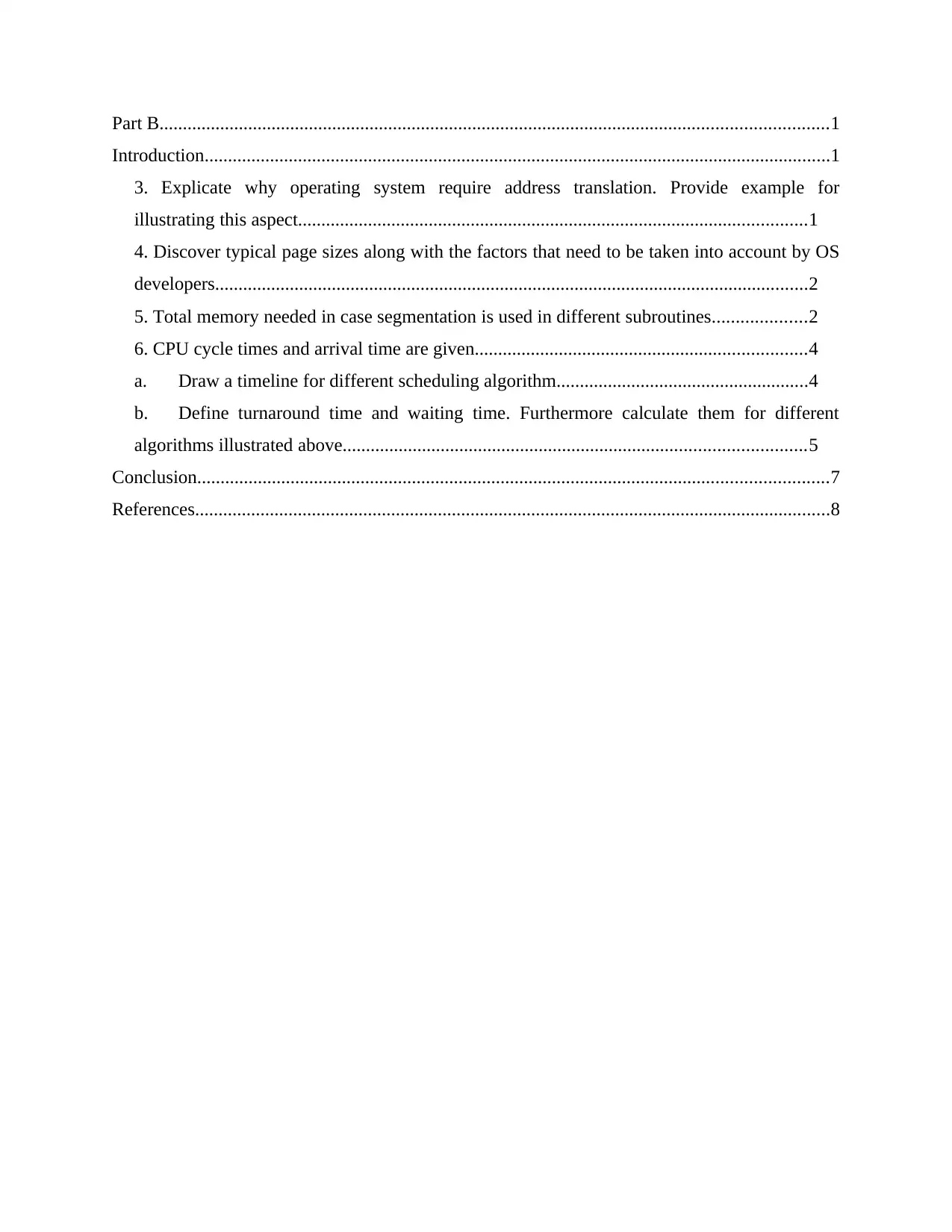
Part B...............................................................................................................................................1
Introduction......................................................................................................................................1
3. Explicate why operating system require address translation. Provide example for
illustrating this aspect.............................................................................................................1
4. Discover typical page sizes along with the factors that need to be taken into account by OS
developers...............................................................................................................................2
5. Total memory needed in case segmentation is used in different subroutines....................2
6. CPU cycle times and arrival time are given.......................................................................4
a. Draw a timeline for different scheduling algorithm......................................................4
b. Define turnaround time and waiting time. Furthermore calculate them for different
algorithms illustrated above...................................................................................................5
Conclusion.......................................................................................................................................7
References........................................................................................................................................8
Introduction......................................................................................................................................1
3. Explicate why operating system require address translation. Provide example for
illustrating this aspect.............................................................................................................1
4. Discover typical page sizes along with the factors that need to be taken into account by OS
developers...............................................................................................................................2
5. Total memory needed in case segmentation is used in different subroutines....................2
6. CPU cycle times and arrival time are given.......................................................................4
a. Draw a timeline for different scheduling algorithm......................................................4
b. Define turnaround time and waiting time. Furthermore calculate them for different
algorithms illustrated above...................................................................................................5
Conclusion.......................................................................................................................................7
References........................................................................................................................................8
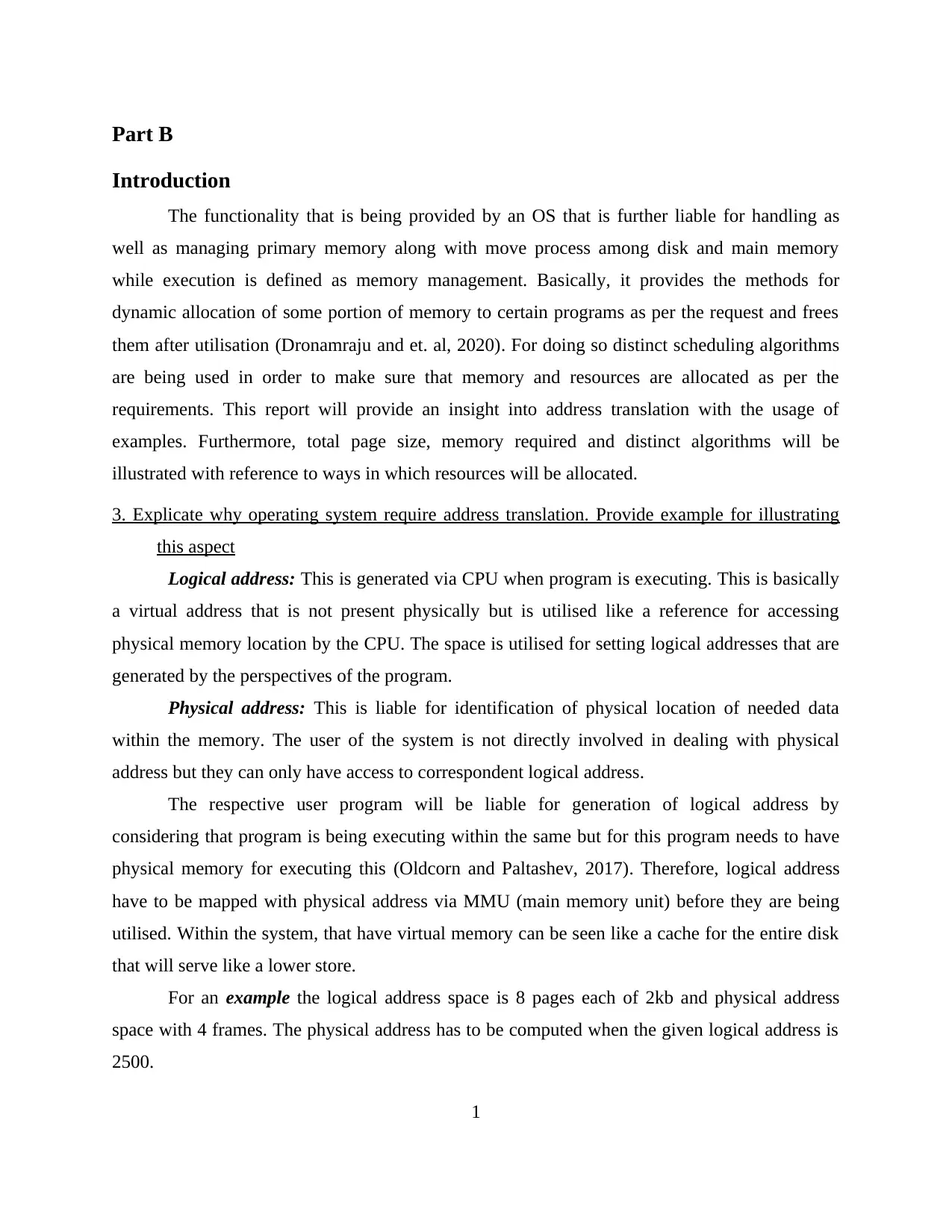
Part B
Introduction
The functionality that is being provided by an OS that is further liable for handling as
well as managing primary memory along with move process among disk and main memory
while execution is defined as memory management. Basically, it provides the methods for
dynamic allocation of some portion of memory to certain programs as per the request and frees
them after utilisation (Dronamraju and et. al, 2020). For doing so distinct scheduling algorithms
are being used in order to make sure that memory and resources are allocated as per the
requirements. This report will provide an insight into address translation with the usage of
examples. Furthermore, total page size, memory required and distinct algorithms will be
illustrated with reference to ways in which resources will be allocated.
3. Explicate why operating system require address translation. Provide example for illustrating
this aspect
Logical address: This is generated via CPU when program is executing. This is basically
a virtual address that is not present physically but is utilised like a reference for accessing
physical memory location by the CPU. The space is utilised for setting logical addresses that are
generated by the perspectives of the program.
Physical address: This is liable for identification of physical location of needed data
within the memory. The user of the system is not directly involved in dealing with physical
address but they can only have access to correspondent logical address.
The respective user program will be liable for generation of logical address by
considering that program is being executing within the same but for this program needs to have
physical memory for executing this (Oldcorn and Paltashev, 2017). Therefore, logical address
have to be mapped with physical address via MMU (main memory unit) before they are being
utilised. Within the system, that have virtual memory can be seen like a cache for the entire disk
that will serve like a lower store.
For an example the logical address space is 8 pages each of 2kb and physical address
space with 4 frames. The physical address has to be computed when the given logical address is
2500.
1
Introduction
The functionality that is being provided by an OS that is further liable for handling as
well as managing primary memory along with move process among disk and main memory
while execution is defined as memory management. Basically, it provides the methods for
dynamic allocation of some portion of memory to certain programs as per the request and frees
them after utilisation (Dronamraju and et. al, 2020). For doing so distinct scheduling algorithms
are being used in order to make sure that memory and resources are allocated as per the
requirements. This report will provide an insight into address translation with the usage of
examples. Furthermore, total page size, memory required and distinct algorithms will be
illustrated with reference to ways in which resources will be allocated.
3. Explicate why operating system require address translation. Provide example for illustrating
this aspect
Logical address: This is generated via CPU when program is executing. This is basically
a virtual address that is not present physically but is utilised like a reference for accessing
physical memory location by the CPU. The space is utilised for setting logical addresses that are
generated by the perspectives of the program.
Physical address: This is liable for identification of physical location of needed data
within the memory. The user of the system is not directly involved in dealing with physical
address but they can only have access to correspondent logical address.
The respective user program will be liable for generation of logical address by
considering that program is being executing within the same but for this program needs to have
physical memory for executing this (Oldcorn and Paltashev, 2017). Therefore, logical address
have to be mapped with physical address via MMU (main memory unit) before they are being
utilised. Within the system, that have virtual memory can be seen like a cache for the entire disk
that will serve like a lower store.
For an example the logical address space is 8 pages each of 2kb and physical address
space with 4 frames. The physical address has to be computed when the given logical address is
2500.
1
⊘ This is a preview!⊘
Do you want full access?
Subscribe today to unlock all pages.

Trusted by 1+ million students worldwide

Size of page = 2kb. (This means that 14 bits are required for offset)
Pages = 8 (Thus, 3 bits for each)
The given virtual address is 2500 in binary = 000 00100111000100
The initial three bits from left indicates page number and rest offset
Page number = 000
Offset = 00100111000100
Page 0 is mapped with frame 1. This means that physical address will be 0100100111000100 =
18884.
4. Discover typical page sizes along with the factors that need to be taken into account by OS
developers
It is important to divide jobs into equal parts before they are loaded, this is known as page
which will be loaded into the memory location referred to as page frame. The concept of paged
memory allocation is dependent on segregating the jobs that are coming into pages that are of
identical size (Silberschatz, Galvin and Gagne, 2014). It entirely depends upon the operating
system that is present within the computer. In some system the page size is identical memory
block size as well as this is alike to size of each section of the disk in which job is present or
stored.
The operating system developer, before execution of the program takes into account
certain aspects, they are as following:
Identification of number of pages present within the program
Determining empty page frames that are in the main memory
Load program pages within them
This will enable them to prepare program for loading where pages are present in the
logical sequence that is first page will comprise of initial instructions for the program and
similarly goes for the last.
5. Total memory needed in case segmentation is used in different subroutines
The wasted space in each of the allocated space due to rounding up from actual required
allocation to allocation granularity is defined as internal fragmentation. This takes place when
memory is segregated within fixed sized block. Whenever any request is for the memory by
process then fixed size blocks are allocated. In this context, the memory that is being provided is
2
Pages = 8 (Thus, 3 bits for each)
The given virtual address is 2500 in binary = 000 00100111000100
The initial three bits from left indicates page number and rest offset
Page number = 000
Offset = 00100111000100
Page 0 is mapped with frame 1. This means that physical address will be 0100100111000100 =
18884.
4. Discover typical page sizes along with the factors that need to be taken into account by OS
developers
It is important to divide jobs into equal parts before they are loaded, this is known as page
which will be loaded into the memory location referred to as page frame. The concept of paged
memory allocation is dependent on segregating the jobs that are coming into pages that are of
identical size (Silberschatz, Galvin and Gagne, 2014). It entirely depends upon the operating
system that is present within the computer. In some system the page size is identical memory
block size as well as this is alike to size of each section of the disk in which job is present or
stored.
The operating system developer, before execution of the program takes into account
certain aspects, they are as following:
Identification of number of pages present within the program
Determining empty page frames that are in the main memory
Load program pages within them
This will enable them to prepare program for loading where pages are present in the
logical sequence that is first page will comprise of initial instructions for the program and
similarly goes for the last.
5. Total memory needed in case segmentation is used in different subroutines
The wasted space in each of the allocated space due to rounding up from actual required
allocation to allocation granularity is defined as internal fragmentation. This takes place when
memory is segregated within fixed sized block. Whenever any request is for the memory by
process then fixed size blocks are allocated. In this context, the memory that is being provided is
2
Paraphrase This Document
Need a fresh take? Get an instant paraphrase of this document with our AI Paraphraser
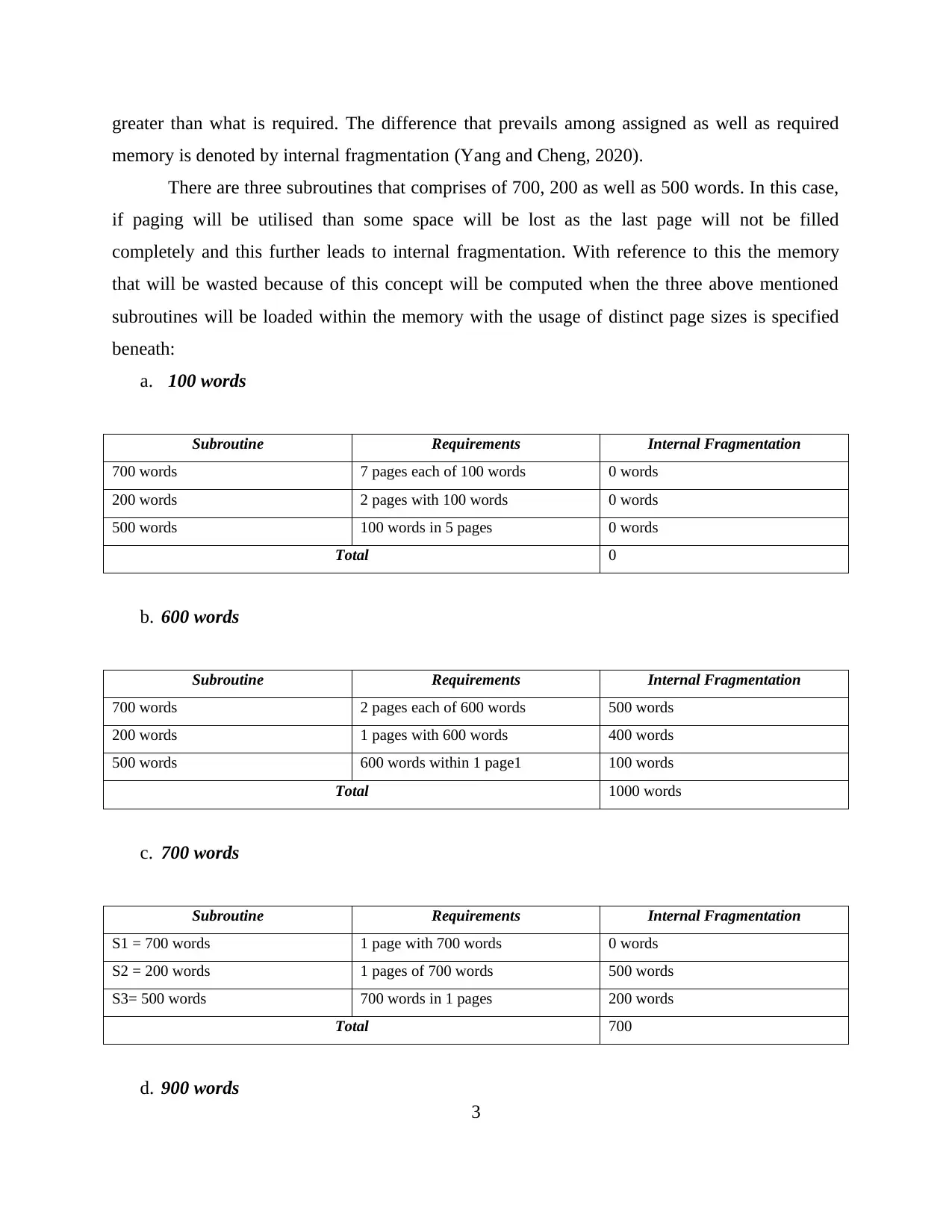
greater than what is required. The difference that prevails among assigned as well as required
memory is denoted by internal fragmentation (Yang and Cheng, 2020).
There are three subroutines that comprises of 700, 200 as well as 500 words. In this case,
if paging will be utilised than some space will be lost as the last page will not be filled
completely and this further leads to internal fragmentation. With reference to this the memory
that will be wasted because of this concept will be computed when the three above mentioned
subroutines will be loaded within the memory with the usage of distinct page sizes is specified
beneath:
a. 100 words
Subroutine Requirements Internal Fragmentation
700 words 7 pages each of 100 words 0 words
200 words 2 pages with 100 words 0 words
500 words 100 words in 5 pages 0 words
Total 0
b. 600 words
Subroutine Requirements Internal Fragmentation
700 words 2 pages each of 600 words 500 words
200 words 1 pages with 600 words 400 words
500 words 600 words within 1 page1 100 words
Total 1000 words
c. 700 words
Subroutine Requirements Internal Fragmentation
S1 = 700 words 1 page with 700 words 0 words
S2 = 200 words 1 pages of 700 words 500 words
S3= 500 words 700 words in 1 pages 200 words
Total 700
d. 900 words
3
memory is denoted by internal fragmentation (Yang and Cheng, 2020).
There are three subroutines that comprises of 700, 200 as well as 500 words. In this case,
if paging will be utilised than some space will be lost as the last page will not be filled
completely and this further leads to internal fragmentation. With reference to this the memory
that will be wasted because of this concept will be computed when the three above mentioned
subroutines will be loaded within the memory with the usage of distinct page sizes is specified
beneath:
a. 100 words
Subroutine Requirements Internal Fragmentation
700 words 7 pages each of 100 words 0 words
200 words 2 pages with 100 words 0 words
500 words 100 words in 5 pages 0 words
Total 0
b. 600 words
Subroutine Requirements Internal Fragmentation
700 words 2 pages each of 600 words 500 words
200 words 1 pages with 600 words 400 words
500 words 600 words within 1 page1 100 words
Total 1000 words
c. 700 words
Subroutine Requirements Internal Fragmentation
S1 = 700 words 1 page with 700 words 0 words
S2 = 200 words 1 pages of 700 words 500 words
S3= 500 words 700 words in 1 pages 200 words
Total 700
d. 900 words
3
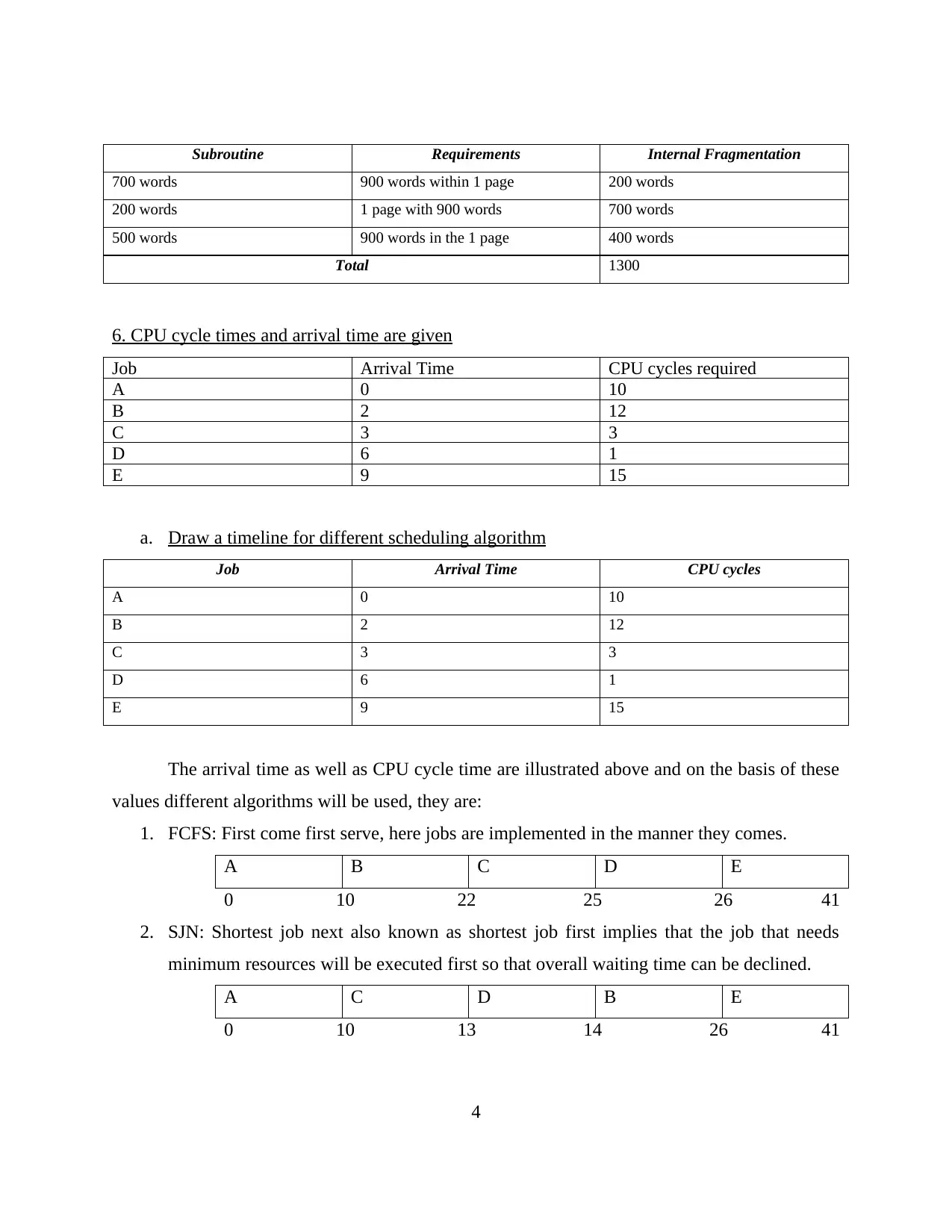
Subroutine Requirements Internal Fragmentation
700 words 900 words within 1 page 200 words
200 words 1 page with 900 words 700 words
500 words 900 words in the 1 page 400 words
Total 1300
6. CPU cycle times and arrival time are given
Job Arrival Time CPU cycles required
A 0 10
B 2 12
C 3 3
D 6 1
E 9 15
a. Draw a timeline for different scheduling algorithm
Job Arrival Time CPU cycles
A 0 10
B 2 12
C 3 3
D 6 1
E 9 15
The arrival time as well as CPU cycle time are illustrated above and on the basis of these
values different algorithms will be used, they are:
1. FCFS: First come first serve, here jobs are implemented in the manner they comes.
A B C D E
0 10 22 25 26 41
2. SJN: Shortest job next also known as shortest job first implies that the job that needs
minimum resources will be executed first so that overall waiting time can be declined.
A C D B E
0 10 13 14 26 41
4
700 words 900 words within 1 page 200 words
200 words 1 page with 900 words 700 words
500 words 900 words in the 1 page 400 words
Total 1300
6. CPU cycle times and arrival time are given
Job Arrival Time CPU cycles required
A 0 10
B 2 12
C 3 3
D 6 1
E 9 15
a. Draw a timeline for different scheduling algorithm
Job Arrival Time CPU cycles
A 0 10
B 2 12
C 3 3
D 6 1
E 9 15
The arrival time as well as CPU cycle time are illustrated above and on the basis of these
values different algorithms will be used, they are:
1. FCFS: First come first serve, here jobs are implemented in the manner they comes.
A B C D E
0 10 22 25 26 41
2. SJN: Shortest job next also known as shortest job first implies that the job that needs
minimum resources will be executed first so that overall waiting time can be declined.
A C D B E
0 10 13 14 26 41
4
⊘ This is a preview!⊘
Do you want full access?
Subscribe today to unlock all pages.

Trusted by 1+ million students worldwide

3. SRT: Shortest remaining time in which processor will be allocated to job that is about to
be completed but this might be pre-empted in case if new job arrives with shorter time for
accomplishment.
A B C D A B E
0 2 3 6 7 15 26 41
4. Round Robin: It is a pre-emptive scheduling algorithm where fix time is provided for
execution. In this case, t=4.
A B C A D E A B B E
0 4 8 11 15 16 20 22 26 30 41
b. Define turnaround time and waiting time. Furthermore calculate them for different
algorithms illustrated above.
Different methods or formulas are used for computing waiting as well as turnaround time.
They are:
Waiting time = turnaround time – CPU cycles required
Turnaround time = Completion time – arrival time
1. FCFS:
Proces
s
Arrival Time CPU cycle Completion Time Turnaround Time Waiting Time
A 0 10 10 10 0
B 2 12 22 20 8
C 3 3 25 22 19
D 6 1 26 20 19
E 9 15 41 32 17
2. SJN:
Proces Arrival Time CPU cycle Completion Time Turnaround Time Waiting Time
5
be completed but this might be pre-empted in case if new job arrives with shorter time for
accomplishment.
A B C D A B E
0 2 3 6 7 15 26 41
4. Round Robin: It is a pre-emptive scheduling algorithm where fix time is provided for
execution. In this case, t=4.
A B C A D E A B B E
0 4 8 11 15 16 20 22 26 30 41
b. Define turnaround time and waiting time. Furthermore calculate them for different
algorithms illustrated above.
Different methods or formulas are used for computing waiting as well as turnaround time.
They are:
Waiting time = turnaround time – CPU cycles required
Turnaround time = Completion time – arrival time
1. FCFS:
Proces
s
Arrival Time CPU cycle Completion Time Turnaround Time Waiting Time
A 0 10 10 10 0
B 2 12 22 20 8
C 3 3 25 22 19
D 6 1 26 20 19
E 9 15 41 32 17
2. SJN:
Proces Arrival Time CPU cycle Completion Time Turnaround Time Waiting Time
5
Paraphrase This Document
Need a fresh take? Get an instant paraphrase of this document with our AI Paraphraser
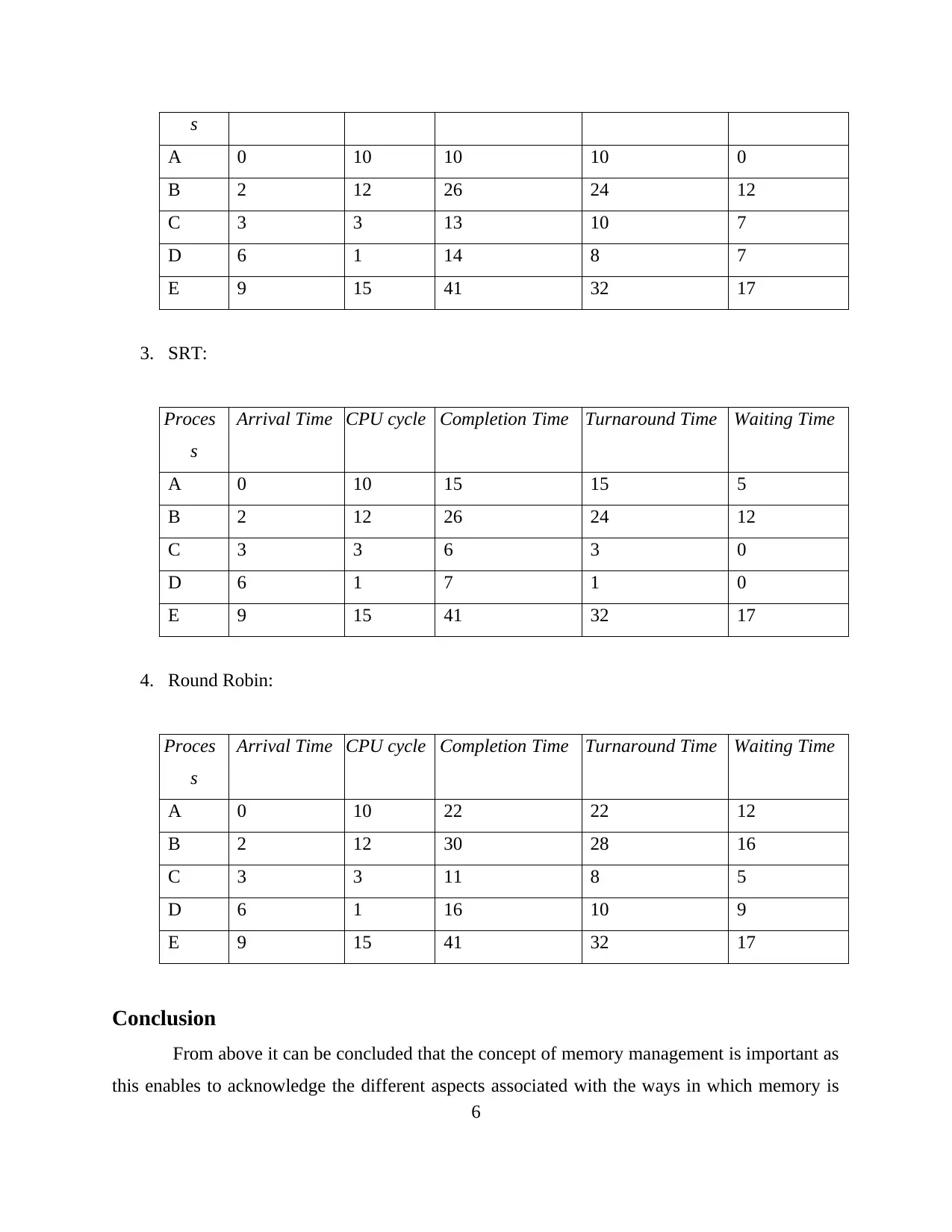
s
A 0 10 10 10 0
B 2 12 26 24 12
C 3 3 13 10 7
D 6 1 14 8 7
E 9 15 41 32 17
3. SRT:
Proces
s
Arrival Time CPU cycle Completion Time Turnaround Time Waiting Time
A 0 10 15 15 5
B 2 12 26 24 12
C 3 3 6 3 0
D 6 1 7 1 0
E 9 15 41 32 17
4. Round Robin:
Proces
s
Arrival Time CPU cycle Completion Time Turnaround Time Waiting Time
A 0 10 22 22 12
B 2 12 30 28 16
C 3 3 11 8 5
D 6 1 16 10 9
E 9 15 41 32 17
Conclusion
From above it can be concluded that the concept of memory management is important as
this enables to acknowledge the different aspects associated with the ways in which memory is
6
A 0 10 10 10 0
B 2 12 26 24 12
C 3 3 13 10 7
D 6 1 14 8 7
E 9 15 41 32 17
3. SRT:
Proces
s
Arrival Time CPU cycle Completion Time Turnaround Time Waiting Time
A 0 10 15 15 5
B 2 12 26 24 12
C 3 3 6 3 0
D 6 1 7 1 0
E 9 15 41 32 17
4. Round Robin:
Proces
s
Arrival Time CPU cycle Completion Time Turnaround Time Waiting Time
A 0 10 22 22 12
B 2 12 30 28 16
C 3 3 11 8 5
D 6 1 16 10 9
E 9 15 41 32 17
Conclusion
From above it can be concluded that the concept of memory management is important as
this enables to acknowledge the different aspects associated with the ways in which memory is
6

allocated to distinct resources. In addition to this, there are different algorithms that are being
designed for doing so depending upon the requirement of the system.
7
designed for doing so depending upon the requirement of the system.
7
⊘ This is a preview!⊘
Do you want full access?
Subscribe today to unlock all pages.

Trusted by 1+ million students worldwide
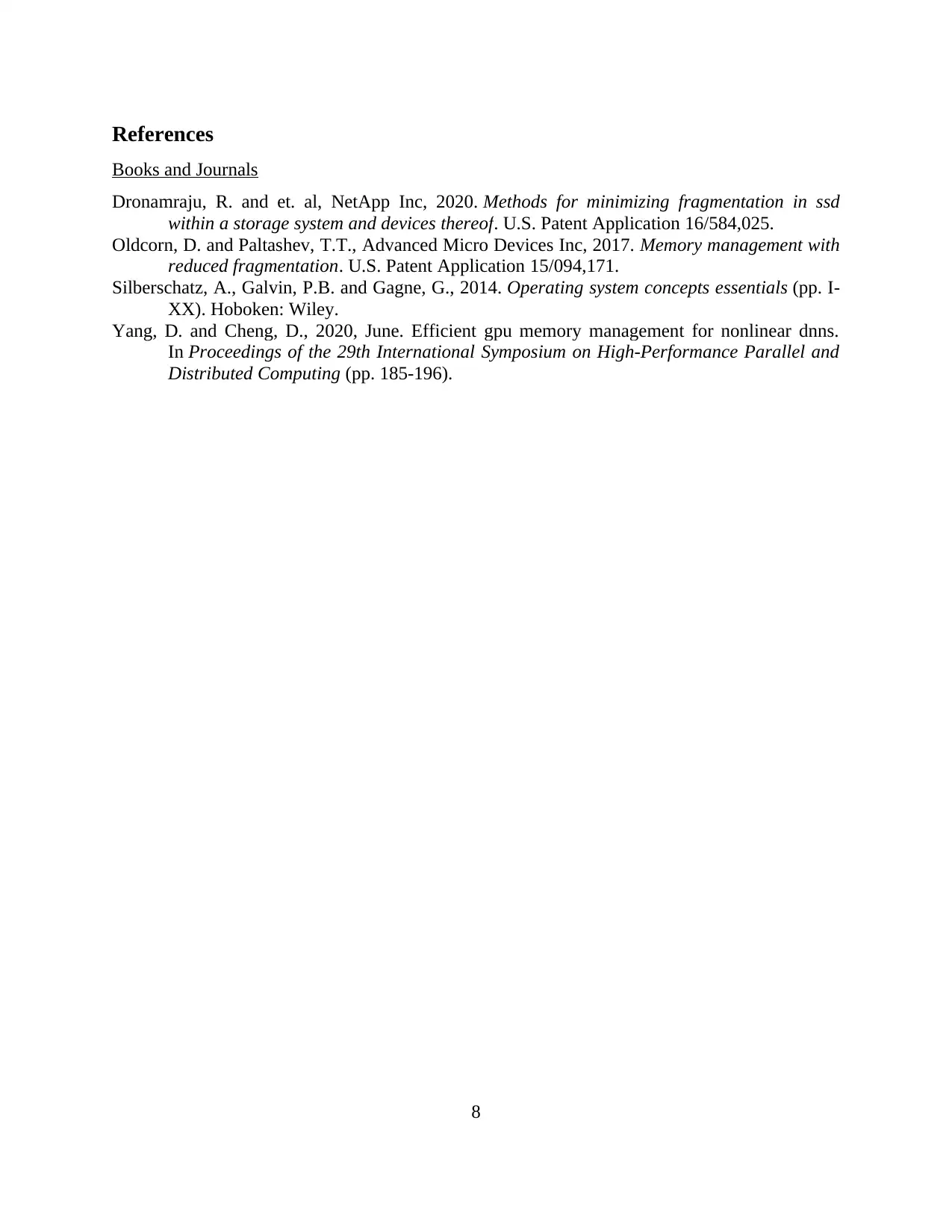
References
Books and Journals
Dronamraju, R. and et. al, NetApp Inc, 2020. Methods for minimizing fragmentation in ssd
within a storage system and devices thereof. U.S. Patent Application 16/584,025.
Oldcorn, D. and Paltashev, T.T., Advanced Micro Devices Inc, 2017. Memory management with
reduced fragmentation. U.S. Patent Application 15/094,171.
Silberschatz, A., Galvin, P.B. and Gagne, G., 2014. Operating system concepts essentials (pp. I-
XX). Hoboken: Wiley.
Yang, D. and Cheng, D., 2020, June. Efficient gpu memory management for nonlinear dnns.
In Proceedings of the 29th International Symposium on High-Performance Parallel and
Distributed Computing (pp. 185-196).
8
Books and Journals
Dronamraju, R. and et. al, NetApp Inc, 2020. Methods for minimizing fragmentation in ssd
within a storage system and devices thereof. U.S. Patent Application 16/584,025.
Oldcorn, D. and Paltashev, T.T., Advanced Micro Devices Inc, 2017. Memory management with
reduced fragmentation. U.S. Patent Application 15/094,171.
Silberschatz, A., Galvin, P.B. and Gagne, G., 2014. Operating system concepts essentials (pp. I-
XX). Hoboken: Wiley.
Yang, D. and Cheng, D., 2020, June. Efficient gpu memory management for nonlinear dnns.
In Proceedings of the 29th International Symposium on High-Performance Parallel and
Distributed Computing (pp. 185-196).
8
1 out of 10
Your All-in-One AI-Powered Toolkit for Academic Success.
+13062052269
info@desklib.com
Available 24*7 on WhatsApp / Email
![[object Object]](/_next/static/media/star-bottom.7253800d.svg)
Unlock your academic potential
Copyright © 2020–2025 A2Z Services. All Rights Reserved. Developed and managed by ZUCOL.

